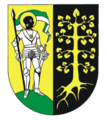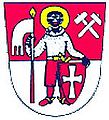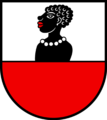Mauritius (saint)
Mauritius (Latin, also Mauricius ; German: Moritz , French Maurice ; * allegedly with Thebes in Egypt ; † allegedly around 290 in Agaunum (Saint-Maurice) in Valais ) was, according to legend, the leader of the Thebaic Legion and is in the Catholic and venerated as a saint by the Orthodox Church since the 4th century . His Evangelical and Roman Catholic Memorial Day is September 22nd , while the Orthodox Memorial Day falls on December 27th .
Saint Mauritius was a patron saint of the army, infantry, knife and weapon smiths and was invoked before fights, skirmishes and battles.
The imperial sword and the holy lance , parts of the imperial regalia , were also traced back to the holy Mauritius from the High Middle Ages.
Legend

The oldest known tradition of the legend comes from Eucherius , who was bishop in Lyon between 428 and 450 . This was based on oral reports from sources who, in turn, learned the story of Bishop Isaac of Geneva. So the report comes from (at least) a third party. For a long time the descriptions were considered a historical fact, but they have been the subject of scientific controversy since the Reformation . According to Denis van Berchem , the story of Mauritius comes from Syria , where bishop Theodor von Sitten probably also came from.
According to the legend of Eucherius, Mauritius was in command of a legion that had been raised from predominantly Christian men at Thebes in Egypt at the time of the Roman emperors Diocletian and Maximian . Candidus and Exuperius served as officers of the Mauritius . Emperor Maximian then incorporated the so-called Thebaic Legion into his army, which he wanted to use against the Christians. The legend emphasizes the cruelty of the emperor.
When crossing the Alps , the 6600 men of the Theban Legion mutinied in the narrow area near Agaunum , because they did not want to go against the Christians. The event took place in the year 302 or 303, depending on the source. Maximian was staying in Octodurum ( Martigny ) at the time and angrily gave the order to decimate the Legion , i. H. to execute every tenth man. A further decimation did not lead to success either, which is why the emperor ordered the total destruction of the legion. Without resistance, the officers and men would have let themselves be executed as martyrs for their religion. Fleeing members of the Legion were executed in Solothurn ( Ursus and Victor ).
Adoration

Late antiquity and early Middle Ages
During late antiquity and the early Middle Ages, Mauritius was worshiped primarily as a member of the Theban Legion . This early veneration at their place of execution can be traced back to the 4th century. The relics of the Thebes were found by the Bishop of Octodurum , later canonized Theodor von Sitten , in Agaunum, today's St-Maurice in Valais in Switzerland. He put them back in the Cour du Martolet between 386 and 392 and built a burial church (basilica) there . In 430 Mauritius and companions appeared in the Martyrologium Hieronymianum . So they were probably part of a local church calendar.
Eucherius tells of a miracle story that probably took place around 450, in which a woman came to Agaune and successfully prayed for the healing of her paralysis. So there was already a pilgrimage to the place of suffering of the martyrs. In this context, Eucherius also tells of the existence of a hostel (hospitium) and donations in the form of silver and gold. Apparently the bones of the legionaries had already achieved considerable fame in Eucherius' time. Agaune was probably also popular with pilgrims because it was geographically favorable for pilgrims who crossed the Alps on a north-south journey.
In 515, Sigismund , designated King of the Burgundians , founded the Saint-Maurice Abbey and professionalized the pilgrimage there. The first pope who verifiably visited the Mauritius tomb was Stephen II at the end of 753 in order to conduct diplomatic negotiations with the Frankish king Pippin at this location - but the king did not appear. A famous Carolingian visitor was Charles the Bald in 875. While the early tradition still revered the Thebes as a group, the travel reports from St-Maurice up to the 9th century show an increasing focus on the person of Mauritius.
In the early Middle Ages there was already a religious life in St-Maurice, which was favored by the location above a mass grave. This enabled the monks to publish numerous “real” Thebaic relics, each of which could theoretically be that of St. Mauritius (or at the request of another particular saint). The relics were given away only to monasteries, chapels or churches; some were also affiliated with foundations . Examples of beneficiaries of the Mauritius relics are Auxerre , Cologne , Magdeburg , Echternach , Centula and Siegburg. Although relics for foundations were welcome, there were some that went on without such equipment. Mauritius first appears as the patron saint , as the village in Agaune was named more and more frequently after its monastery and is still today. The veneration spread most strongly to the north and northeast, in addition to the first foundations, Mauritius altars were in several monasteries and churches on Germanic territory. A spread since the 6th century can also be seen in Gallic territory. Both secular and spiritual donors were involved. Masses were held in honor of the murdered legionnaire. In the lists of martyrs, Mauritius usually appeared on a par with many other saints.
Kingdom of Burgundy and Liudolfinger
From 888 Mauritius was venerated as the patron saint of the Kingdom of Burgundy after the Burgundian King Rudolf , who was Abbot of St-Maurice, had crowned himself at the tomb of the martyr.
Under the Liudolfingers , the Mauritius cult began to flourish in the East Franconian Empire. Otto the Great in particular showed great interest in this saint. In 937 he founded the Benedictine Mauritius Monastery in Magdeburg , presumably with the intention of later turning it into a bishopric. He dedicated this monastery to two figures of the Thebaic Legion, Mauritius and Innocentius , as well as St. Peter . At Christmas 960 Otto took over from King Konrad III in Regensburg . from Burgundy the "body of St. Mauritius and some of his companions". He immediately sent the relics to the Moritz monastery in Magdeburg, "where the unanimously assembled inhabitants and the rural population took them into custody and venerated them for the good of the whole country to this day". Otto's first wife Edgitha died in 946 and had her buried in the Mauritius monastery. At this point, where today's Magdeburg Cathedral stands, Otto had a new church built in 955. He chose the church as a burial place for himself and his wife. He himself was buried there in 973 after his entrails had already been buried at the place of his passing in Memleben .
From the beginning of his reign until his own death, Otto I dedicated a total of 57 documents to Saint Mauritius and his monastery / church, which he gave richly. According to the documents, this was primarily aimed at personal and family salvation. Since 965 at the latest, Mauritius has been documented as the personal patron of the emperor. 962 confirmed Pope John XII. the veneration of Mauritius as the patron saint of the Ottonians . After all, Saint Mauritius was considered the patron saint of all emperors of the Holy Roman Empire and of the empire itself.
Modern times
In the 15th century, the Counts of Savoy founded the Knightly Order of St. Mauritius and Lazarus , which still exists today.
Mauritius lance
The view that Mauritius was also in possession of the Holy Lance probably dates from the High Middle Ages. Early Ottonian historians called it "lancea sacra". The earliest written evidence of this change in meaning can be found in a letter written around 1000 from Bruno von Querfurt , which, however, does not yet speak directly of the Mauritius lance. Only in the middle of the 11th century can the lance be identified in written sources as "lancea sancti Mauritij". Under Henry III. the reinterpretation was so dominant that he had the lance covered with a silver cuff with a Mauritius inscription.
The name Mauritius lance comes from its origin: From 921 the lance was owned by King Rudolf II of Burgundy, in whose kingdom the Mauritius cult was most influential. He exchanged it in 926 with the East Franconian King Heinrich I for the region around Basel . His son Otto the Great, who was also a great admirer of Mauritius, took up the cult of the lance and led it victoriously in the battle on the Lechfeld . As a result, the cult around the lance and Mauritius were very strongly linked. In the High Middle Ages, the Mauritius lance was considered one of the most powerful sacred objects, as it guaranteed invincibility to the wearer in battle.
Patronage
Numerous churches and monasteries are under the patronage of St. Mauritius; one of the most important is the Angers Cathedral . Mauritius is the patron saint of the cities of Coburg , Fröndenberg / Ruhr , Wiesbaden , Ingolstadt and Zwickau as well as the Niederaltaich monastery .
Furthermore, he is the patron saint of all craftsmen who deal with dark colors, i.e. the knife and weapon smiths , dyers , shopkeepers, hat makers , glass painters , salt boilers , cloth weavers and washers as well as the patron saint of horses. He is called in case of ear problems, obsession, gout and sick children.
On July 19, 1941, Pope Pius XII. Mauritius is the patron saint of the Alpini Corps of the Italian Army .
The Christian scouts - Mauritius - Twistringen tribe have chosen him as patron saint.
presentation

From the beginning Mauritius was represented as a Roman officer in chain mail, also with a shield and a lance flag; he can already be found on the Milanese ivory tablet, which depicts either Otto I or Otto II. Since the representation in Magdeburg about 1250 Mauritius is in the iconography depicted as black Mauritanians, including at the famous Erasmus Mauritius panel of Matthias Grünewald . He also appears as black in the coats of arms of the cities of Coburg and Zwickau . He is also the namesake of the local Moriz Church . It is also present in the coat of arms of the Wolffskeel and Grumbach families , and through them it has entered the coats of arms of their former estates. Saint Mauritius is also included as a Moor in the coat of arms of the von Tucher family . Mauritius figures can be found on the town halls of Jüterbog and Eisleben , which were built at the beginning of the 16th century .
Mauritius in heraldry
For example, Mauritius is represented in the following coats of arms:
literature
- Adalbert Josef Herzberg: The holy Mauritius. A contribution to the history of the German worship of Mauritius . Schwann, Düsseldorf 1936 ( Research on Folklore 25/26, ISSN 1860-3408 ), (Reprint: ibid 1981, ISBN 3-590-32203-9 ).
- Gude Suckale-Redlefsen: Mauritius. The holy moor. The Black Saint Maurice . Schnell, Munich et al. 1987, ISBN 3-7954-0240-9 .
- Maurice Zufferey: The Mauritius cult in the early and high Middle Ages . In: Historical yearbook . tape 106 , 1986, ISSN 0018-2621 , pp. 23-58 .
- Ekkart Sauser : MAURITIUS and companions. In: Biographisch-Bibliographisches Kirchenlexikon (BBKL). Volume 17, Bautz, Herzberg 2000, ISBN 3-88309-080-8 , Sp. 918-919.
- Eric Chevalley: Mauritius. In: Historical Lexicon of Switzerland .
Web links
- Literature from and about Mauritius in the catalog of the German National Library
- Passio Acaunensium Martyrum in: MGH Scriptores rerum Merovingicarum, Vol. 3, pp. 20ff. dmgh
Individual evidence
- ^ Synaxarium of the Orthodox Church. In: www.synaxarion.gr. Retrieved June 2, 2016 .
- ↑ passio Acaunensium martyrum. (No longer available online.) In: MGH Script. rer. Merov., Passiones I. pp. 20-41 , formerly in the original ; Retrieved February 8, 2009 (annotated Latin text). ( Page no longer available , search in web archives ) Info: The link was automatically marked as defective. Please check the link according to the instructions and then remove this notice.
- ↑ For a research overview on historicity cf. Herzberg, Der Heilige Mauritius , p. 10ff; Thomas Bauer: Thebes. In: Biographisch-Bibliographisches Kirchenlexikon (BBKL). Volume 11, Bautz, Herzberg 1996, ISBN 3-88309-064-6 , Sp. 784-791.
- ↑ a b Maurice Zufferey: The Mauritius cult in the early and high Middle Ages .
- ↑ Liber Pontificalis 94.24.
- ^ Annals of St. Bertin , 875/876.
- ↑ St. Servatius Treasury and Healing Chamber. In: Treasury of Saint Servatius. Archdiocese of Cologne, November 12, 2019, accessed on November 12, 2019 .
- ^ Thietmar von Merseburgs Chronik II, 17.
- ^ Thietmar von Merseburgs Chronik II, 3; Widukind von Corvey , Res gestae Saxonicae II, 41.
- ^ Thietmar von Merseburgs Chronik II, 11.
- ↑ Thietmar von Merseburgs Chronik II, 43; Widukind von Corvey , Res gestae Saxonicae III, 75-76.
- ↑ Johannes Laudage: Otto the Great (912–973). A biography . Regensburg 2001, ISBN 3-7917-1750-2 , p. 30ff.
- ↑ MGH DD O I., I, No. 293: "... deo sanctoque martyri Mauricio, nostro scilicet patrono ...", and further no. 304: "... deo omnipotenti sanctoque martyri Mauricio, nostro scilicet patrono. .. “, and also no. 306.
- ^ Widukind von Corvey : Res gestae Saxonicae I, 25.
- ↑ Bruno von Querfurt turns against the alliance between the Christian King Heinrich II and the pagan Ljutizen, for which he contrasts Christianity and paganism. Two consecutive questions connect the pairs Mauritius / Holy Lance on the one hand and the heathen god Zuarasi / “diabolica vexilla” on the other. Cf. A. Brackmann: The political significance of Mauritius worship in the early Middle Ages. In: Meeting reports of the Prussian Academy of Sciences in Berlin , Berlin 30.1937, p. 292f.
- ^ For example: Ekkehard von St. Gallen , Casus sancti Galli , c. 65; Hugo von Flavigny , Chronicon II, 29; Benzo from Alba, Ad Heinricum IV. Imperatorem I, 9.
- ↑ See: M. Kuhn: Saint Mauritius with the lance, the Ottonian imperial patron. In: Geschichte am Obermain , Vol. 7, Lichtenfels 1971–1972; P. 54f. Bühler claims, however, that it was not until Henry IV. 1084 that the cuff was attached, cf. A. Bühler, St. Lance, a contribution to the history of the German imperial regalia ; in: Das Münster 16.1963, pp. 85–116.
- ↑ Liutprand of Cremona , Antapodosis IV, 25th
- ↑ Esercito Italiano: I Patroni delle Armi Corpi e Specialità - Gli Alpini ( Memento of the original dated August 11, 2014 in the Internet Archive ) Info: The archive link was inserted automatically and has not yet been checked. Please check the original and archive link according to the instructions and then remove this notice. .
- ↑ Cf.: Gude Suckale-Redlefsen: Der heilige Mohr ; Bernd Feicke: City history and the jewelry of historic town halls on the Harz ... , in: Harz research , vol. 23, Berlin 2007, pp. 254–266
| personal data | |
|---|---|
| SURNAME | Mauritius |
| ALTERNATIVE NAMES | St. Moritz; St. Maurice |
| BRIEF DESCRIPTION | Roman military leader, martyr and saint |
| DATE OF BIRTH | 2nd century or 3rd century |
| PLACE OF BIRTH | Thebes , Egypt |
| DATE OF DEATH | at 290 |
| Place of death | Agaunum , Wallis |

















